Chinese Movies
The Unstoppable Success of Ne Zha 2: Breaking Global Records and Sparking Debate on Chinese Social Media
Everyone’s talking about Ne Zha 2—from in-depth online analyses to the booming market surrounding the film.
Published
2 months agoon
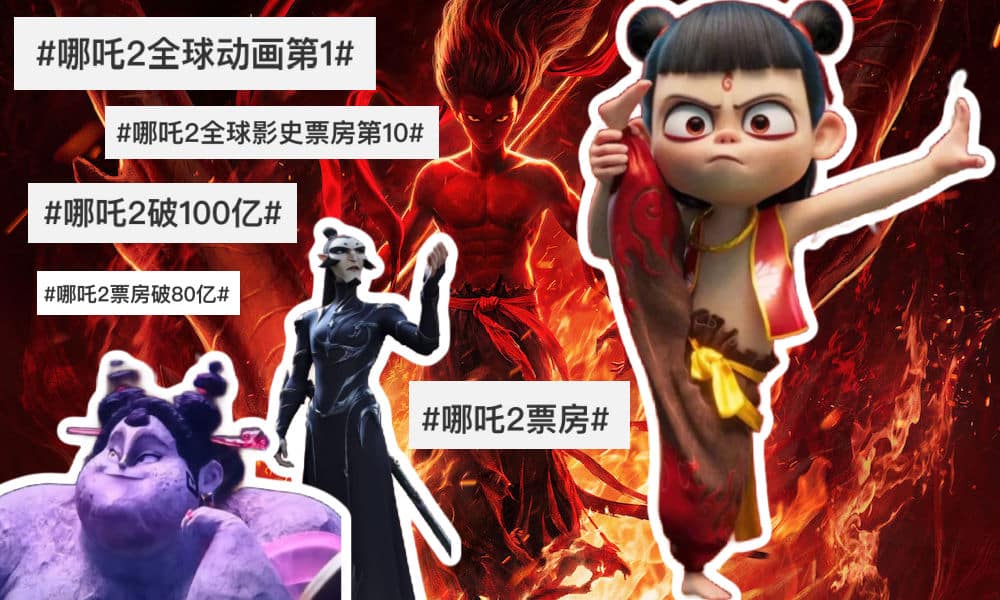
China’s animated blockbuster Ne Zha 2 (哪吒之魔童闹海) is smashing box office records and igniting debates on Chinese social media—from its most popular supporting characters to the question of which town can truly claim Nezha as its own.
The Chinese animation blockbuster Ne Zha 2 (哪吒之魔童闹海) has been a major point of discussion in China recently—not just for the movie itself, but also for its box office performance, which has become a hot topic on Weibo and beyond.
Just nine days after its release on January 29, Ne Zha 2 had already surpassed the 2021 film The Battle at Lake Changjin (长津湖), which had previously held the title of the highest-grossing Chinese film of all time—surpassing Wolf Warrior 2 (战狼2).

China’s top 3 highest-grossing movies: Ne Zha 2, Battle at Lake Changjin, and Wolf Warrior 2
In mid-February, Chinese netizens were eagerly anticipating Ne Zha 2 reaching the 10 billion yuan milestone (about $1.37 billion). At the time, the film had already grossed over 9.8 billion yuan ($1.35 billion), securing its place as the 17th highest-grossing film worldwide and the only non-Hollywood film in the top 20.
Now, the film’s global box office performance has surpassed all expectations: it has exceeded 13.8 billion yuan ($1.90 billion) as of February 25, placing Ne Zha 2 among the top eight highest-grossing films of all time worldwide. On Tuesday, it already became the highest-grossing animated film in global history.
In response to the film’s overwhelming success, there have been all kinds of memes, trends, and hashtags on Chinese on social media.
The official Weibo account of The Battle at Lake Changjin published a post to congratulate Ne Zha 2 making new record for Chinese cinema history. This tradition is known as the “Box Office Champion Poster Relay,” originally initiated by Chinese director Xu Zheng (徐峥) in 2015 with the hope of fostering camaraderie and encouragement among filmmakers in China.

On February 6, the official Weibo account of The Battle at Lake Changjin published a post to congratulate Ne Zha 2 making new record for Chinese cinema history.
Earlier in February, Weibo users created the hashtag “The Least Educated Film Star of All Time” (#史上学历最低的影帝#) to celebrate Nezha—a 3-year-old mythological hero.
With the combined success of Nezha 1 and Nezha 2, they jokingly call Nezha the ‘youngest character’ to ever surpass the 10-billion-yuan box office milestone.
One popular comment said:
“Congratulations! The least educated film star in history (didn’t even finish kindergarten), and the youngest one to hold a 10-billion-yuan box office record, is our darling little Nezha.”
Nezha 2 is directed by Yang Yu (杨宇), also known as Jiaozi (饺子), and co-produced by Coco Cartoon (可可豆动画), Coloroom Pictures (彩条屋影业), and others. Released during the Spring Festival holiday, the film continues the storyline from its 2019 predecessor Nezha 1.
Based on Chinese mythology, the film follows the legendary figures Nezha (哪吒) and Ao Bing (敖丙), both characters from 16th-century classic Chinese novel Investiture of the Gods (封神演义). This narrative delves into the history of the Shang (c. 1600-c. 1046 BC) and Zhou (c. 1046-771 BC) dynasties, weaving together folklore, legends, and a variety of mythical beings and creatures.
Nezha and Ao Bing face a dire crisis—their souls remain intact, but their bodies are on the brink of disintegration. To save them, Nezha’s master, Taiyi Zhenren (太乙真人), plans to restore their forms using the mystical Seven-Colored Lotus.
The protagonist, Nezha, is a prominent figure from Chinese mythology and folklore. Besides in Investiture of the Gods, he also appears in Journey to the West (西游记). In Taiwan, Nezha is often revered as the “Third Prince” (三太子, Sān Tàizǐ), as he is the third son of Li Jing (李靖), also known as the Pagoda-Bearing Heavenly King Li (托塔李天王), in these mythological tales.

Ne Zha 2 promo image, China Daily.
Ne Zha 1 and Ne Zha 2 are not the first animated works centered around the character of Nezha.
The 1979 classic film Nezha Conquers the Dragon King (哪吒闹海), produced by Shanghai Animation Film Studio (上海美术电影制片厂), was China’s first large-scale color widescreen animated feature. It depicted Nezha’s conflict with the ‘Dragon King of the East Sea’ (东海龙王) and included the iconic scene where Nezha returns his bones to his father and flesh to his mother. His self-sacrifice in white robes is regarded as one of the most powerful moments in Chinese animation history. With its traditional Chinese aesthetics, this version of Nezha remains a beloved classic, particularly among those born in the 1970s and 1980s.

An important scene of “Nezha Conquers the Dragon King,” where Nezha is about to sacrifice himself to protect the people of Chentang Pass.
For those born in the 1990s and 2000s, childhood memories of Nezha are often linked to the 2003 animated TV series The Legend of Nezha (哪吒传奇), produced by China International Television Corporation. The theme song of this 52-episode series, “Young Hero Nezha” (少年英雄小哪吒), remains a nostalgic tune familiar to many from that era.
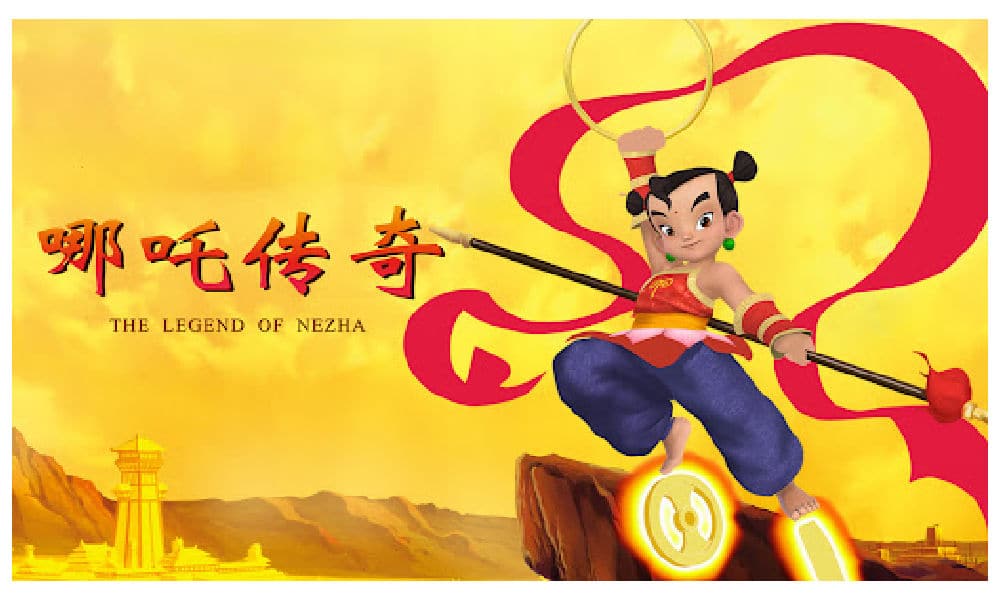
The Legend of Nezha
The shared cultural memory of Nezha, along with the overwhelmingly positive reception of Ne Zha 1 in 2019, has undoubtedly laid a strong foundation for the success of Ne Zha 2. Combined with five years of dedicated production—with some one-minute scenes taking up to six months (!) to conceptualize—it seems Ne Zha 2 was destined for cinematic success.
The Evolution of Nezha
Chinese audiences have had a variety of reactions to Ne Zha 2. Many viewers have expressed their love for the film, with some claiming to have watched it multiple times—some as many as six times—in different cinema formats to find the best viewing experience.
Some have found unique interpretations of some of the film’s details. Under various hashtags (e.g. #哪吒2隐喻引热议#), netizens actively discuss and analyze references in the film. These include a dollar sign-like symbol on the celestial artifact Tianyuan Ding (天元鼎) and scenes that seem to allude to the Bretton Woods system, sparking speculation that the film hints at global economic dynamics.
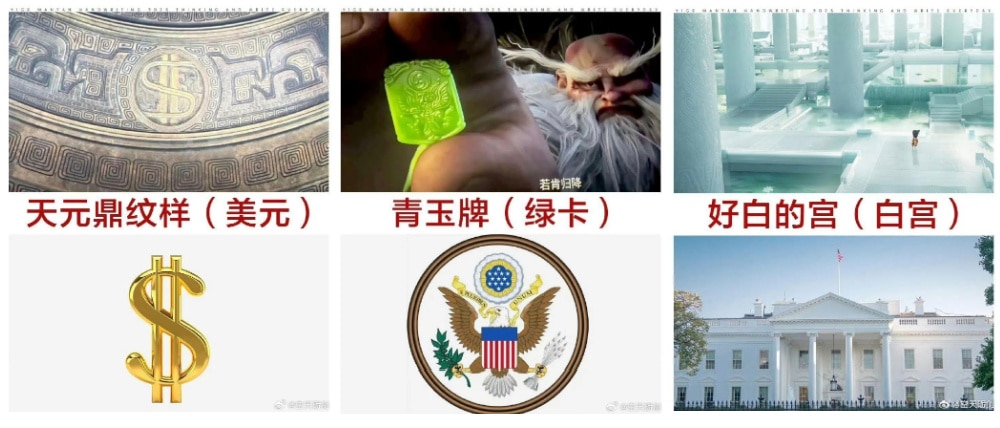
Hidden messages in Ne Zha 2? Some netizens think there are.
Not all feedback has been positive. Some viewers have criticized the film for how it prioritizes traditional values like filial piety in Nezha’s character rather than rebellion, feeling it does not really suit the spirit of his character.
One Weibo commenter (@我不是小日王) wrote:
“I’m not sure if I can say this, but honestly, I don’t really like the changes made to the story line in Nezha 2. In my memory, Nezha was not just the super strong and determined god of the Three Altar Sea Gathering, but also a lonely wanderer. Despite being deeply influenced by Confucian culture, where “filial piety is the greatest virtue” (百善孝为先), he still displayed rebellious behavior going against all morality by returning his flesh to his father and bones to his mother. He’s a genuine pioneer in rejecting patriarchal society (as referenced in Jiang Xun’s Six Lectures on Loneliness). But [in Nezha 2], to make him more relatable to the masses, he is forcibly portrayed as a filial, harmonious, superhero-like little boy.”
The movie’s fighting scenes and the depiction of Nezha as an overly reckless character have also drawn some disapproval. One Weibo user wrote:
“After watching the first film, I thought it was good—a troublemaking demon child defying fate to save the world. After going through so much, you’d at least expect some character growth. But in the second film, he’s still looking for trouble, throwing tantrums whenever he faces difficulties, and howling all the time. I honestly don’t see any charm in his character at all.”
Despite the success of Ne Zha 2, for those who already had a favorite version of Nezha, the changes to the character might be a bit harder to accept.
Beijing Business Newspaper (北京商报) recently posted an overview on Weibo of Nezha’s evolution, suggesting that “every generation has its own Nezha.” From the arrogant deity in the 1961 Havoc in Heaven (大闹天宫) to the defiant rebel in the 1979 Nezha Conquers the Dragon King (哪吒闹海) or the clever and courageous young hero in the 2003 The Legend of Nezha (哪吒传奇), the character has continuously evolved with the times.
From “Small-town Swot” to Stone Diva
It is not only the figure of Nezha that has dominated discussions surrounding Ne Zha 2. Some of the other characters in the film are also resonating with audiences and have become a popular topic of discussion on Chinese social media.
One of the most beloved characters is Shen Gongbao (申公豹). A villain in the first film, Ne Zha 2 adds more depth to his character, leading many viewers to empathize with his struggles.
As a hardworking overachiever with a stutter, not particularly born into privilege like many of the celestial figures in the film, some Chinese netizens suggest that he represents the experience of many “small-town swots” (xiǎozhèn zuòtíjiā 小镇做题家) in China.

Shen Gongbao (申公豹) has become China’s most beloved villain.
“Small-town swot” is a buzzword that has appeared on Chinese social media over the past few years, first popping up on a Douban forum. It refers to students from rural areas and small towns in China who put in immense effort to secure a place at a top university and move to bigger cities. While they may excel academically, even ranking as top scorers, they often struggle to gain social advantages, highlighting a deeper rural-urban divide in China.
Initially used in a self-deprecating manner, the term became a way for people from modest backgrounds to vent their frustrations and self-doubt, eventually striking a chord with many others.
There is now a series of hashtags about Shen Gongbao being a small-town swot (#申公豹 小镇做题家#, #申公豹丑强惨#, #申公豹 真男人#), all adding to the popularity of this character.
Another standout character is Lady Stone (石矶娘娘), a larger-than-life demon whom Nezha must overcome in his celestial trials. She has gained attention for her grand, imposing presence – a bold and diva-like figure who once was a stone.
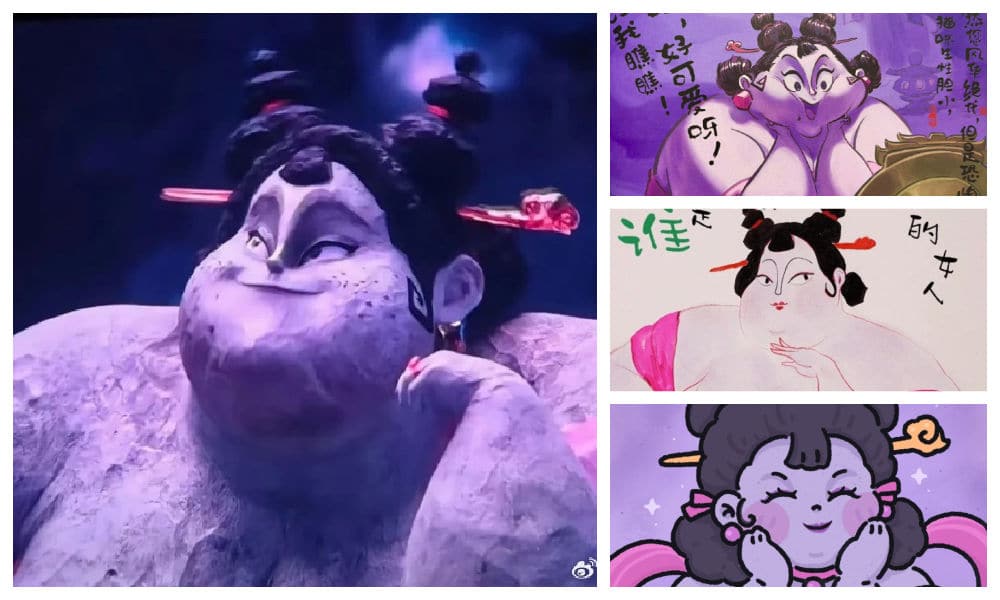
Lady Stone from Ne Zha 2, and the fan art dedicated to her.
Lady Stone first appears questioning a magic mirror about her beauty, and after being defeated by Nezha, she ultimately accepts her unique form. Some Chinese netizens see her as a challenge to traditional beauty standards, leading to the hashtag “Lady Stone Breaks Beauty Stereotypes” (#石矶娘娘打破白幼瘦审美枷锁#) and countless fan art contributions, celebrating her as a symbol of self-acceptance and female resilience.
The Rise of “Ne Zha Economy”
As the box office success of Ne Zha 2 continues to skyrocket, its economic impact is becoming increasingly evident.
By early February, the film had already generated most of the annual revenue for its production company, Enlight Media (光线传媒). The company’s shares hit an all-time high, soaring over 150% in just six trading days. With box office numbers still rising, Enlight Media’s profits are expected to grow even further, signaling a strong financial outlook.
The film’s success has also had a positive impact on cinema chains. Hengdian Entertainment (横店影视) hit the daily trading limit, while Wanda Film (万达电影) and Bona Film Group (博纳影业) saw their shares rise by over 6%. Other companies in the sector also experienced stock price gains.
Beyond the box office, Ne Zha 2 has driven a surge in related merchandise sales. The film’s characters appear in numerous commercial ads, and Pop Mart’s (泡泡玛特) Ne Zha 2 blind box figurines have been so popular that many stores are down to display items only. Pop Mart’s stock price also hit a new high, significantly boosting its market value.
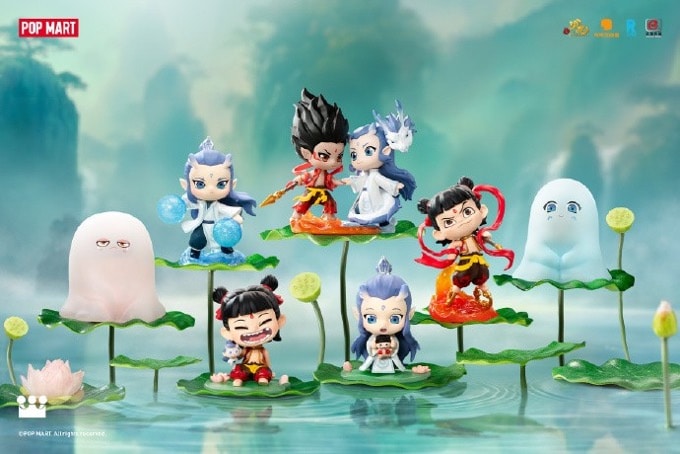
The Ne Zha 2 blind box figurines from Pop Mart.
In terms of tourism, several regions across China are also looking to capitalize on the film’s popularity. Since Chentang Pass (陈塘关), Nezha’s birthplace in Investiture of the Gods, lacks a clearly defined real-world location, multiple cities are hoping to claim the title of “Nezha’s hometown” (#多地争给哪吒上户口#).
Because Tianjin is a sea city that has a place called “Chentangzhuang”, it already started to promote itself on social media as being Nezha’s birthplace with the hashtag: “Nezha’s Hometown, Tianjin, Invites You to Visit” (#哪吒故里天津喊你来打卡#).
Meanwhile, residents of Chengdu argue that their city is Nezha’s true “home”, since Ne Zha 2 was registered in Chengdu, the director is a native of Sichuan, and the production team, Coco Cartoon, is based in Gazelle Digital Cultural and Creative Valley located in Chengdu’s Tianfu Software Park.
The film is undeniably a “Chengdu-made” production, with elements of Sichuan culture woven throughout, from Taiyi Zhenren’s Sichuan-accented Mandarin to the two Boundary Beasts that look like the bronze masks of Sanxingdui, and the bamboo chairs, covered tea bowls, and flying eaves of Sichuanese architecture in Chentang Pass.
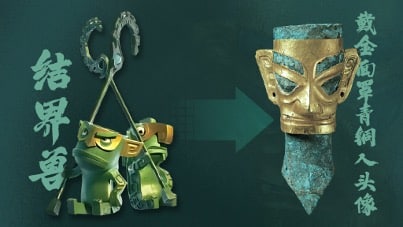
The appearance of two Boundary Beasts (结界兽, Jie2 Jie4 Shou4) is inspired by the bronze masks of Sanxingdui.
For cities with no claim to Nezha’s birthplace, local tourism campaigns have instead spotlighted Nezha temples as must-visit attractions.
How ‘International’ is Ne Zha’s Global Success?
What’s still in store for Ne Zha 2? The Chinese film industry analytics platform Maoyan predicts that the final box office earnings for Ne Zha 2 in mainland China could reach 16 billion yuan ($2.2 billion).
If this figure becomes a reality, the film wouldn’t just be the highest-grossing animated movie—it would also rank among the top five highest-grossing films in global box office history.
But how much of its box office success is truly global? Outside of China, Ne Zha 2 began its international release in mid-February 2025, with a limited release in markets like the United States, Australia, and New Zealand.
By February 20, Deadline reported that $1.72 billion of its earnings came from China alone, indicating that the vast majority of its box office revenue is domestically driven.
However, if anyone questions the significance of the international market’s contribution to Ne Zha 2’s success, they might receive a response similar to that of Wu Jing (吴京), director of the Wolf Warrior (战狼) series. When faced with skepticism about Wolf Warrior 2 making it into the top 100 global box office hits despite 99% of its earnings coming from mainland China, he simply replied:
“So what? That’s still money” (#所以呢 不是钱吗#).
By Wendy Huang
Follow @whatsonweibo
With contributions from Manya Koetse and edited for clarity
Spotted a mistake or want to add something? Please let us know in comments below or email us. Please note that your comment below will need to be manually approved if you’re a first-time poster here.
©2025 Whatsonweibo. All rights reserved. Do not reproduce our content without permission – you can contact us at info@whatsonweibo.com
Wendy Huang is a China-based Beijing Language and Culture University graduate who currently works for a Public Relations & Media software company. She believes that, despite the many obstacles, Chinese social media sites such as Weibo can help Chinese internet users to become more informed and open-minded regarding various social issues in present-day China.
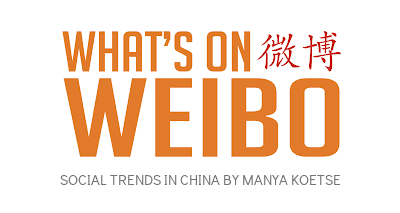
China Memes & Viral
How Ne Zha 2’s Shen Gongbao Became Known as the Ultimate “Small-Town Swot”
Published
1 month agoon
March 1, 2025
PART OF THIS TEXT COMES FROM THE WEIBO WATCH PREMIUM NEWSLETTER
Over the past few weeks, the Chinese blockbuster Ne Zha 2 has been trending on Weibo every single day. The movie, loosely based on Chinese mythology and the Chinese canonical novel Investiture of the Gods (封神演义), has triggered all kinds of memes and discussions on Chinese social media (read more here and here).
One of the most beloved characters is the leopard demon Shen Gongbao (申公豹). While Shen Gongbao was a more typical villain in the first film, the narrative of Ne Zha 2 adds more nuance and complexity to his character. By exploring his struggles, the film makes him more relatable and sympathetic.
In the movie, Shen is portrayed as a sometimes sinister and tragic villain with humorous and likeable traits. He has a stutter, and a deep desire to earn recognition. Unlike many celestial figures in the film, Shen Gongbao was not born into privilege and never became immortal. As a demon who ascended to the divine court, he remains at the lower rungs of the hierarchy in Chinese mythology. He is a hardworking overachiever who perhaps turned into a villain due to being treated unfairly.
Many viewers resonate with him because, despite his diligence, he will never be like the gods and immortals around him. Many Chinese netizens suggest that Shen Gongbao represents the experience of many “small-town swots” (xiǎozhèn zuòtíjiā 小镇做题家) in China.
“Small-town swot” is a buzzword that has appeared on Chinese social media over the past few years. According to Baike, it first popped up on a Douban forum dedicated to discussing the struggles of students from China’s top universities. Although the term has been part of social media language since 2020, it has recently come back into the spotlight due to Shen Gongbao.
“Small-town swot” refers to students from rural areas and small towns in China who put in immense effort to secure a place at a top university and move to bigger cities. While they may excel academically, even ranking as top scorers, they often find they lack the same social advantages, connections, and networking opportunities as their urban peers.
The idea that they remain at a disadvantage despite working so hard leads to frustration and anxiety—it seems they will never truly escape their background. In a way, it reflects a deeper aspect of China’s rural-urban divide.
Some people on Weibo, like Chinese documentary director and blogger Bianren Guowei (@汴人郭威), try to translate Shen Gongbao’s legendary narrative to a modern Chinese immigrant situation, and imagine that in today’s China, he’d be the guy who trusts in his hard work and intelligence to get into a prestigious school, pass the TOEFL, obtain a green card, and then work in Silicon Valley or on Wall Street. Meanwhile, as a filial son and good brother, he’d save up his “celestial pills” (US dollars) to send home to his family.
Another popular blogger (@痴史) wrote:
“I just finished watching Ne Zha and my wife asked me, why do so many people sympathize with Shen Gongbao? I said, I’ll give you an example to make you understand. Shen Gongbao spent years painstakingly accumulating just six immortal pills (xiāndān 仙丹), while the celestial beings could have 9,000 in their hand just like that.
It’s like saving up money from scatch for years just to buy a gold bracelet, only to realize that the trash bins of the rich people are made of gold, and even the wires in their homes are made of gold. It’s like working tirelessly for years to save up 60,000 yuan ($8230), while someone else can effortlessly pull out 90 million ($12.3 million).In the Heavenly Palace, a single meal costs more than an ordinary person’s lifetime earnings.
Shen Gongbao seems to be his father’s pride, he’s a role model to his little brother, and he’s the hope of his entire village. Yet, despite all his diligence and effort, in the celestial realm, he’s nothing more than a marginal figure. Shen Gongbao is not a villain, he is just the epitome of all of us ordinary people. It is because he represents the state of most of us normal people, that he receives so much empathy.”
In the end, in the eyes of many, Shen Gongbao is the ultimate small-town swot. As a result, he has temporarily become China’s most beloved villain.
By Manya Koetse, with contributions by Wendy Huang
Follow @whatsonweibo
Spotted a mistake or want to add something? Please let us know in comments below or email us. Please note that your comment below will need to be manually approved if you’re a first-time poster here.
©2025 Whatsonweibo. All rights reserved. Do not reproduce our content without permission – you can contact us at info@whatsonweibo.com
China ACG Culture
Beyond the Box Office: What’s Behind Ne Zha 2’s Success?
The impact of Ne Zha 2 goes beyond box office figures—yet, in the end, it’s the numbers that matter most.
Published
2 months agoon
February 27, 2025
FROM THE WEIBO WATCH PREMIUM NEWSLETTER
These days, everybody is talking about Ne Zha 2 (哪吒2:魔童闹海), the recent hit film about one of China’s most legendary mythological heroes. With its spectacular visuals, epic battles, funny characters, dragons and deities, and moving scenes, the Chinese blockbuster animation is breaking all kinds of records and has gone from the major hit of this year’s Spring Festival film season to the 7th highest-grossing movie of all time and, with its 13.8 billion yuan ($1.90 billion USD) box office success, now also holds the title of the most successful animated film ever worldwide.
But there is so much more behind this movie than box office numbers alone. There is a collective online celebration surrounding the film, involving state media, brands, and netizens. On Weibo, a hashtag about the movie crossing the 10 billion yuan ($1.38 billion) milestone (#哪吒2破100亿#) has been viewed over a billion times. Social media timelines are filled with fan art, memes, industry discussions, and box office predictions.
The success of Ne Zha 2 is not just a win for China’s animation industry but for “Made in China” productions as a whole. Some argue that Ne Zha‘s triumph is not just cultural but also political, reinforcing China’s influence on the global stage and tying it to the ongoing US-China rivalry: after growing its power in military strength, technology, and AI, China is now making strides in cultural influence as well.
In a recent Weibo post, state broadcaster CCTV also suggested that Hollywood has lost its monopoly over the film industry and should no longer count on the Chinese market—the world’s second-largest movie market—for its box office dominance.
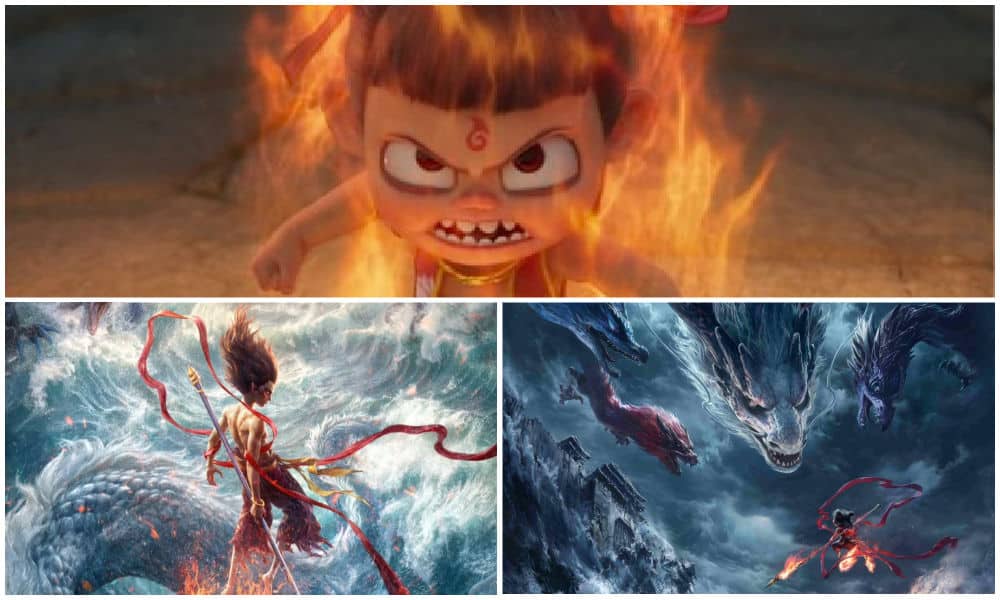
Various images from “Ne Zha 2” 哪吒2:魔童闹海
The success of Ne Zha 2 mainly resonates so deeply because of the past failures and struggles of Chinese animation (donghua 动画). For years, China’s animation industry struggled to compete with American animation studios and Japanese anime, while calls grew louder to find a uniquely Chinese recipe for success—to make donghua great again.
🔹 The Chinese Animation Dream
A year ago, another animated film was released in China—and you probably never heard of it. That film was Ba Jie (八戒之天蓬下界), a production that embraced Chinese mythology through the story of Zhu Bajie, the half-human, half-pig figure from the 16th-century classic Journey to the West (西游记). Ba Jie was a blend of traditional Chinese cultural elements with modern animation techniques, and was seen as a potential success for the 2024 Spring Festival box office race. It took eight years to go from script to screen.
But it flopped.
The film faced numerous setbacks, including significant production delays in the Covid years, limited showtime slots in cinemas, and, most importantly, a very cold reception from the public. On Douban, China’s biggest film review platform, many top comments criticized the movie’s unpolished animation and special effects, and complained that this film—like many before it—was yet another Chinese animation retelling a repetitive story from Journey to the West, one of the most popular works of fiction in China.
“Another mythological character, the same old story,” some wrote. “We’re not falling for low-quality films like this anymore.”
The frustration wasn’t just about Ba Jie—it was about China’s animation industry as a whole. Over the past decade, the quality of Chinese animation films has become a much-discussed topic on social media in China—sometimes sparked by flops, and other times by hits.
Besides Ba Jie, one of those flops was the 2018 The King of Football (足球王者), which took approximately 60 million yuan ($8.8 million) to make, but only made 1.8 million yuan ($267,000) at the box office.
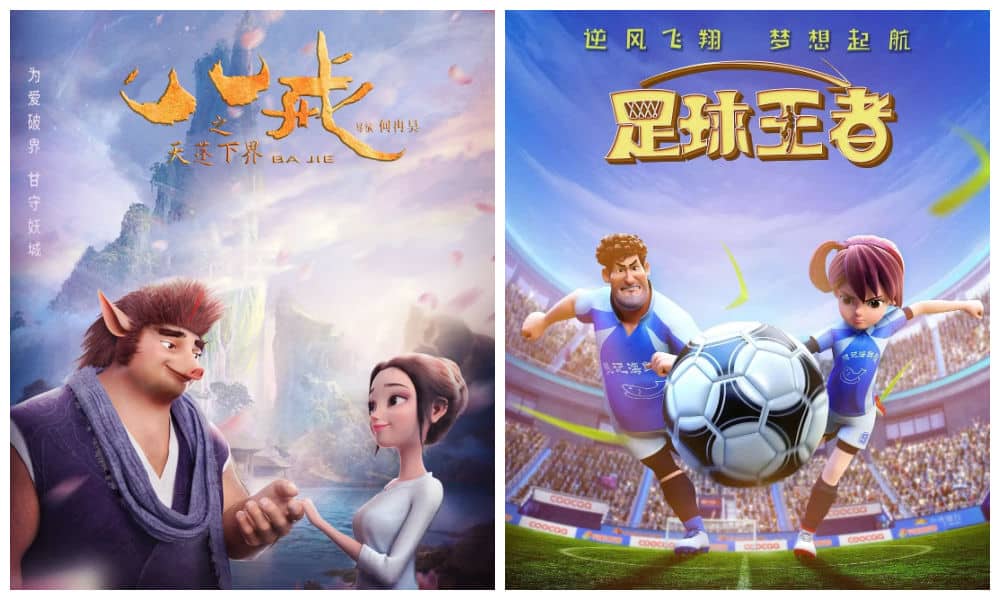
Both Ba Jie, which took years to reach the screen, and King of Football, a high-budget animation, ended up as flops.
One of those successes was the 2019 first Ne Zha film (哪吒之魔童降世), which became China’s highest grossing animated film, or, of the same year, the fantasy animation White Snake (白蛇:缘起), a co-production between Warner Bros and Beijing-based Light Chaser Animation (also the company behind the Ne Zha films). These hits
showed the capabilities and appeal of made-in-China donghua, and sparked conversations about how big changes might be on the horizon for China’s animation industry.
“The only reason Chinese people don’t know we can do this kind of quality film is because we haven’t made any good stories or good films yet,” White Snake filmmaker Zhao Ji (赵霁) said at the time: “We have the power to make this kind of quality film, but we need more opportunities.”
More than just entertainment, China’s animated films—whether successes or failures—have come to symbolize the country’s creative capability. Over the years, and especially since the widespread propagation of the Chinese Dream (中国梦)—which emphasizes national rejuvenation and collective success—China’s ability to produce high-quality donghua with a strong cultural and artistic identity has become increasingly tied to narratives of national pride and soft power. A Chinese animation dream took shape.
🔹 The “Revival” of China’s Animation Industry
A key part of China’s animation dream is to create a 2.0 version of the “golden age” of Chinese animation.
This high-performing era, which took place between 1956 and 1965, was led by the Shanghai Animation Film Studio. While China’s leading animators were originally inspired by American animation (including Disney’s 1937 Snow White and the Seven Dwarfs), as well as German and Russian styles, they were committed to developing a distinctly Chinese animation style—one that incorporated classical Chinese literature, ink painting, symbolism, folk art, and even Peking opera.
Some of the most iconic films from this era include The Conceited General (骄傲的将军, 1956), Why Crows Are Black (乌鸦为什么是黑的, 1956), and most notably, Havoc in Heaven (大闹天宫, 1961 & 1964). Focusing on the legendary Monkey King, Sun Wukong (孙悟空), Havoc in Heaven remains one of China’s most celebrated animated films. On Douban, users have hailed it as “the pride of our domestic animation.”
One of China’s most renowned animation masters, Te Wei (特伟), once explained that the flourishing of China’s animation industry during this golden era was made possible by state support, a free creative atmosphere, a thriving production system, and multiple generations of animators working together at the studio.
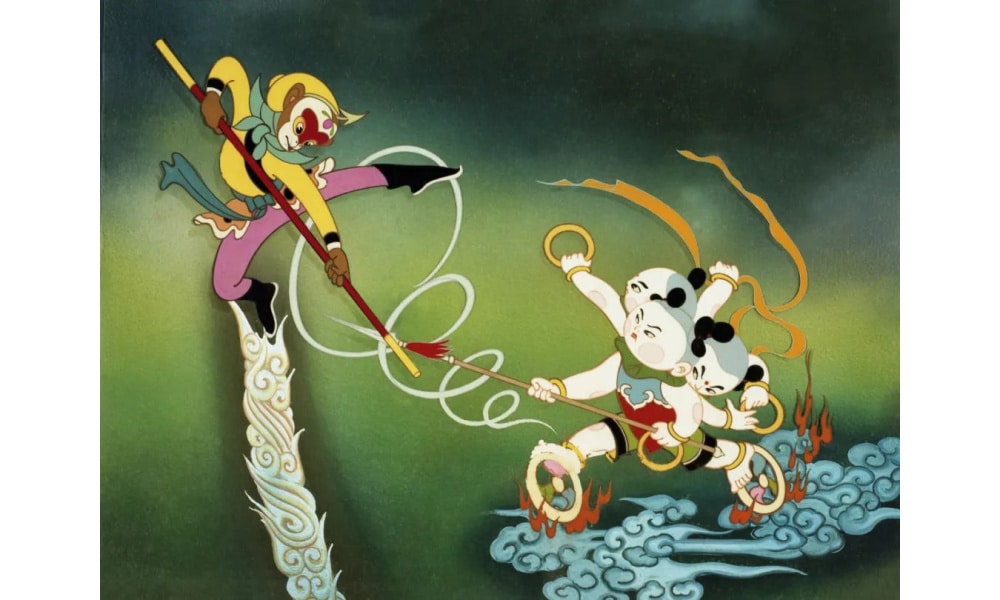
Still from Havoc in Heaven 大闹天宫 via The Paper.
➡️ So what happened to the golden days of Chinese animation?
The decline of this golden era was partly due to the political turmoil of the Cultural Revolution (1966–1976). While there was a second wave of successful productions in the late 1970s and 1980s, the industry lost much of its ‘magic touch’ in the 1990s and 2000s. During this period, Chinese animation studios were pressured to prioritize commercial value, adhere to strict content guidelines, and speed up production to serve the rising domestic TV market—while also taking on outsourcing work for overseas productions.
As the quality and originality of domestic productions lagged behind, the market came to be dominated by imported (often pirated) foreign animations. Japanese series like Astro Boy, Doraemon, and Chibi Maruko-chan became hugely influential among Chinese youth in the 1990s. The strong reaction in China to the 2024 death of Japanese manga artist Akira Toriyama, creator of Dragon Ball, also highlighted the profound impact of Japanese animation on the Chinese market.
This foreign influence also changed viewers’ preferences and aesthetic standards, and many Chinese animations adopted more Japanese or American styles in their creations.
However, this foreign ‘cultural invasion’ was not welcomed by Chinese authorities. As early as 1995, President Jiang Zemin reminded the Shanghai Animation Film Studio of the ideological importance of animation, emphasizing that China needed its “own animated heroes” to serve as “friends and examples” for Chinese youth.
By the early 2010s, the revitalization and protection of China’s animation industry became a national priority. This was implemented through various policies and incentives, including government funding, tax reductions and exemptions for Chinese animation companies, national animation awards, stipulations for the number of broadcasted animations that must be China-made. Additionally, there was an increased emphasis on animation as a tool for cultural diplomacy, focusing on how Chinese animation should reflect national values and history while maintaining global appeal.
It’s important to note that the so-called ‘rejuvenation’ of Chinese animation is not just a cultural and ideological project, there are economic motives at stake too: China’s animation industry is a multi-billion dollar industry.
🔹 “Are We Ne Zha or the Groundhogs?”
The huge success of Ne Zha 2 is seen as a new milestone for Chinese animation and as inspiration for audiences. The film took about five years to complete, reportedly involving 140 animation studios and over 4,000 staff members. The film was written and overseen by director Yang Yu (杨宇), better known as Jiaozi (饺子).
The story is all based on Chinese mythology, following the tumultuous journey of legendary figures Nezha (哪吒) and Ao Bing (敖丙), both characters from the 16th-century classic Chinese novel Investiture of the Gods (Fengshen Yanyi, 封神演义). Unlike Ba Jie or other similar films, the narrative is not considered repetitive or cliché, as Ne Zha 2 incorporates various original interpretations and detailed character designs, even showcasing multiple Chinese dialects, including Sichuan, Tianjin, and Shandong dialects.
One of the film’s unexpected highlights is its clan of comical groundhogs. In this particularly popular scene, Nezha engages in battle against a group of groundhogs (土拨鼠), led by their chief marmot (voiced by director Jiaozi himself). Amid the fierce conflict, most of the groundhogs are hilariously indifferent to the fight itself; instead, they are focused on protecting their soup bowls and continuing to eat—until they are ultimately hunted down and captured.
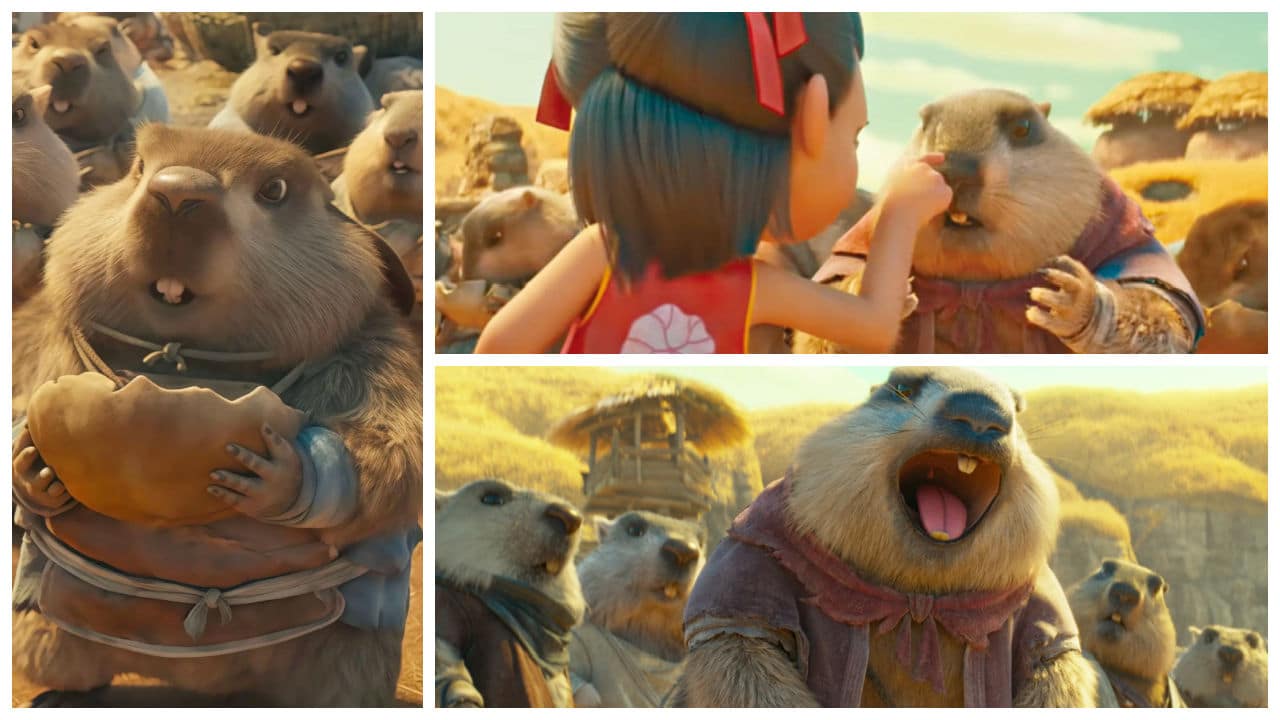
Nezha and the clan of groundhogs.
Besides fueling the social media meme machine, the groundhog scene actually also sparked discussions about social class and struggle. Some commentators began asking, “Are we Ne Zha or the groundhogs?”
Several blogs, including this one, argued that while many Chinese netizens like to identify with Nezha, they are actually more like the groundhogs; they don’t have powerful connections nor super talents. Instead, they are hardworking, ordinary beings, struggling to survive as background figures, positioned at the bottom of the hierarchy.
One comment from a film review captured this sentiment: “At first, I thought I was Nezha—turns out, I’m just a groundhog” (“开局我以为自己是哪咤,结果我是土拨鼠”).
The critical comparisons between Nezha and the groundhogs became politically sensitive when a now-censored article by the WeChat account Fifth Two-Six District (第五二六区) suggested that many Chinese people are so caught in their own information bubbles and mental frameworks that they fail to grasp how the rest of the world operates. The article said: “The greatest irony is that many people think they are Nezha—when in reality, they’re not even the groundhogs.”
While some see a parallel between Nezha’s struggles and their own hardships, others interpret the film’s success as a symbol of China’s rise on the global stage—particularly because the story is so deeply rooted in Chinese culture, literature, and mythology. This has led to an alternative perspective: rather than remaining powerless like the groundhogs, perhaps China—and its people—are transforming into the strong and rebellious Nezha, taking control of their destiny and rising as a global force.
Far-fetched or not, it’s an idea that continues to surface online, along with many other detailed analyses of the film. The nationalist Chinese social media blogger “A Bad Potato” (@一个坏土豆) recently wrote in a Weibo post:
“We were once the groundhog, but today, nobody can make us kneel!” (“我们曾经是土拨鼠,但是今天,没有任何人可以让我们跪下!”)
In another post, the blogger even dragged the Russia-Ukraine war into the discussion, arguing that caring too much about the powerless “groundhogs,” those struggling to survive, does not serve China’s interest. He wrote:
“(..) whether Russia is righteous or evil does not concern me at all. I only care about whether it benefits our great rejuvenation—whoever serves our interests, I support. Only the “traitors” speak hypocritically about love and justice. Speaking about freedom and democracy that we don’t even understand, they wish Russia collapses tomorrow but don’t care if that would lead to us being surrounded by NATO. So, in the end—are we Ne Zha, or are we the groundhog?”
One line from the film that has gained widespread popularity is: “If there is no path ahead, I will carve one out myself!” (“若前方无路,我就踏出一条路!”). Unlike the more controversial groundhog symbolism, this phrase resonates with many as a reflection not only of Nezha’s resilience but also of the determination that has been driving China’s animation industry forward.
The story of Ne Zha 2 goes beyond box office numbers—it represents the global success of Chinese animation, a revival of its golden era, and China’s growing cultural influence. Yet, paradoxically, it’s also all about the numbers. While the vast majority of its earnings come from the domestic market, Ne Zha 2 is still officially a global number-one hit. More than its actual reach worldwide, what truly matters in the eyes of many is that a Chinese animation has managed to surpass the US and Japan at the box office.
While the industry still has room to grow and many markets to conquer, this milestone proves that part of the Chinese animation dream has already come true. And with Ne Zha 3 set for release in 2028, the journey is far from over.
Want to read more on Ne Zha 2? Also check out the Ne Zha 2 buzz article by Wendy Huang here and our related Weibo word of the week here.
By Manya Koetse
(follow on X, LinkedIn, or Instagram)
Some of the research referenced in this text can also be found in an article I published in 2019: The Chinese Animation Dream: Making Made-in-China ‘Donghua’ Great Again. For further reading, see:
►Du, Daisy Yan. 2019. Animated Encounters: Transnational Movements of Chinese Animation, 1940s-1970s. Honolulu: University of Hawaii Press.
►Lent, John A. and Xu Ying. 2013. “Chinese Animation: A Historical and Contemporary Analysis.” Journal of Asian Pacific Communication 23(1): 19-40.
►Saito, Asako P. 2017. “Moe and Internet Memes: The Resistance and Accommodation of Japanese Popular Culture in China.” Cultural Studies Review 23(1), 136-150.
🌟 Attention!
For 11 years, What’s on Weibo has remained a fully independent platform, driven by my passion and the dedication of a small team to provide a window into China’s digital culture and online trends. In 2023, we introduced a soft paywall to ensure the site’s sustainability. I’m incredibly grateful to our loyal readers who have subscribed since then—your support has been invaluable.
But to keep What’s on Weibo thriving, we need more subscribers. If you appreciate our content and value independent China research, please consider subscribing. Your support makes all the difference.
Spotted a mistake or want to add something? Please let us know in comments below or email us. First-time commenters, please be patient – we will have to manually approve your comment before it appears.
©2025 Whatsonweibo. All rights reserved. Do not reproduce our content without permission – you can contact us at info@whatsonweibo.com.
Subscribe

China Reacts: 3 Trending Hashtags Shaping the Tariff War Narrative

No Quiet Qingming: From High-Tech Tomb-Sweeping to IShowSpeed & the Seven China Streams

From Trade Crisis to Patriotic Push: Chinese Online Reactions to Trump’s Tariffs

China Trending Week 14: Gucci Fake Lipstick, Xiaomi SU7 Crash, Yoon’s Impeachment

Strange Encounter During IShowSpeed’s Chengdu Livestream

“Dear Li Hua”: The TikTok/Xiaohongshu Honeymoon Explained

Beyond the Box Office: What’s Behind Ne Zha 2’s Success?

Weibo Watch: A New Chapter

15 Years of Weibo: The Evolution of China’s Social Media Giant

Tuning Into the Year of the Snake

IShowSpeed in China: Streaming China’s Stories Well

TikTok Refugees, Xiaohongshu, and the Letters from Li Hua

The ‘China-chic Girl’ Image and the Realities of China’s Competitive Food Delivery Market

US-Russia Rapprochement and “Saint Zelensky”: Chinese Online Reactions to Trump’s Shake-Up

“Black Myth: Wukong”: From Gaming Screens to the CMG Spring Festival Gala?
Get in touch
Would you like to become a contributor, or do you have any tips or suggestions? Get in touch here!
Popular Reads
-
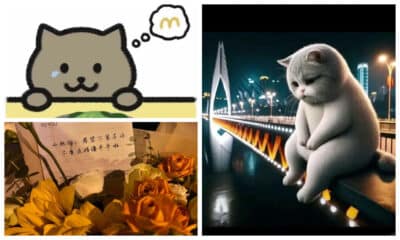
 China Insight11 months ago
China Insight11 months agoThe Tragic Story of “Fat Cat”: How a Chinese Gamer’s Suicide Went Viral
-

 China Digital10 months ago
China Digital10 months agoChina’s 2024 Gaokao Triggers Online Discussions on AI
-

 China Arts & Entertainment11 months ago
China Arts & Entertainment11 months agoSinging Competition or Patriotic Fight? Hunan TV’s ‘Singer 2024’ Stirs Nationalistic Sentiments
-

 China Arts & Entertainment12 months ago
China Arts & Entertainment12 months ago“Old Bull Eating Young Grass”: 86-Year-Old Chinese Painter Fan Zeng Marries 36-Year-Old Xu Meng
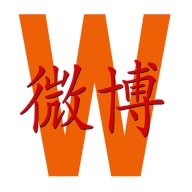





Pingback: Heavy Online Censorship of Articles Critical of Animated Chinese Blockbuster “Ne Zha 2” - Breaking News